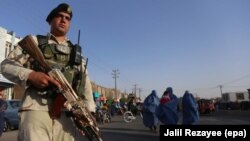The recent attacks on a Shi’ite mosque and the Iraqi Embassy in Afghanistan have stoked fears among the country’s populace that the so-called Islamic State (IS) is trying to gain a foothold in Central Asia for its conflict, previously based out of the Middle East.
IS claimed responsibility for the July 31 embassy attack in Kabul in which a suicide bomber blew himself up at the main gate and gunmen stormed the building.
The group also said it had carried out an August 1 attack at a Shi’ite mosque that killed at least 29 and wounded more than 63 in Herat, a part of western Afghanistan that had previously escaped sectarian attacks by IS.
The Iraqi Embassy being targeted only three weeks after Mosul’s fall to Iraqi troops seemed to confirm warnings from Afghan security officials that IS fighters could start appearing in Afghanistan if they are pushed out of Iraq and Syria.
"This year, we're seeing more new weapons in the hands of the insurgents and an increase in numbers of foreign fighters," said Afghan Defense Ministry spokesman Dawlat Waziri. "They are used on the front lines because they are war veterans."
The number of foreigners fighting for both IS and the Taliban in Afghanistan could be roughly 7,000, estimated a senior security official. Most of these fighters operate across the border from Pakistan, Uzbekistan, or Tajikistan, while others hail from other countries like India.
While foreign fighters have long been present in Afghanistan, there has been growing concern that militants from Arab countries who have left Syria as pressure on IS mounts are now arriving in Afghanistan via Iran.
There is especially concern over the return of Central Asian militants who had been fighting for IS in Iraq and Syria comprising a sizeable part of the group’s military machine.
“Porous borders in the region might help some Central Asian IS fighters to return to our country,” a Middle East-based Afghan diplomat tasked with tracking IS activities in the region told RFE/RL’s Gandhara website.
"We are not talking about a simple militant fighter. We are talking about battle-hardened, educated, and professional fighters in the thousands," another security official said. "They are more dangerous because they can and will easily recruit fighters and foot soldiers here."
The United States is currently mulling sending more troops to Afghanistan, partly to help make sure the country doesn’t become a haven for foreign militant groups.
Despite repeated warnings by Afghan and U.S. officials that foreign fighters from Syria could move over to Afghanistan, there has been considerable skepticism over how many have actually done so.
U.S. commanders maintain that the strength of IS has been greatly diminished through drone strikes and Special Forces operations, in partnership with Afghan security forces.
But intelligence documents obtained by Reuters indicate that security officials believe IS to be in nine provinces, from Nangarhar and Kunar in the east to Jawzjan, Faryab, and Badakhshan in the north and Ghor in the central west.
"In recent operations, we have inflicted heavy losses, but their focus is to recruit fighters from this area," said Juma Gul Hemat, police chief of eastern Kunar Province, where IS fighters pushed out of neighboring Nangarhar have sought refuge. "They are not only from Pakistan or former Taliban, there are fighters from other countries, and other small groups have pledged their allegiance to them," he said.
--With reporting by Hamid Shalizi for Reuters






